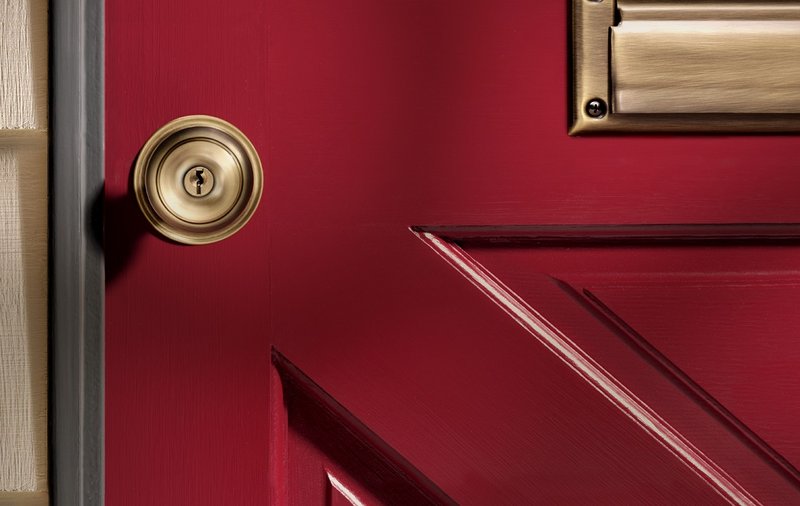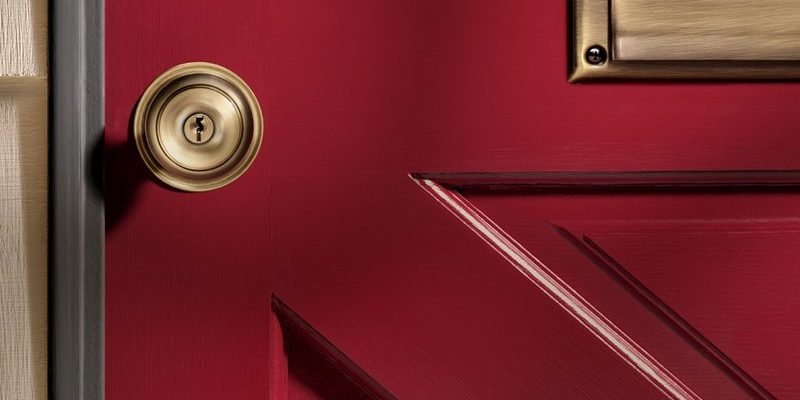
Think of exterior door hardware like a favorite leather jacket. It looks sharp when new, but skip the care and it gets dull, cracked, or stained. The good news? With some regular attention and a few smart habits, it’s possible to keep that brushed nickel, oil-rubbed bronze, or sleek black finish looking fresh for years longer. Let’s break down exactly how to extend the life of those finishes, even when Mother Nature seems determined to put them to the test.
Why Exterior Door Hardware Finishes Wear Out So Fast
Exposure is the number one enemy of any exterior finish. Outdoor door handles, deadbolts, and levers are constantly exposed to sun, rain, temperature swings, and salty or polluted air. Over time, these elements break down the protective coating on the hardware. The UV rays from sunlight are especially harsh, fading and weakening finishes as the months go by. Add in the moisture from rain or snow—and the occasional accidental splashing during garden hose duty—and you’ve got a recipe for corrosion or pitting.
*But that’s not all.* Human hands are part of the equation, too. Oils, sweat, and dirt all contribute to slow, steady finish wear. Every time you open the door, tiny bits of residue get left behind. And if you’re using a key while juggling groceries, you might end up scratching the finish without realizing it.
Honestly, even the type and brand of your hardware matters. For example, Schlage’s advanced coating is better at resisting corrosion, but will still eventually show dull spots if ignored. Cheaper or off-brand hardware can start to fail faster, especially if the finish is only surface-deep and not baked on or electroplated.
Choosing Durable Hardware Finishes: What Really Lasts?
Not all finishes are created equal, even when they look similar on the shelf. If you’re aiming for longevity, look for hardware that’s labeled as “weather-resistant” or has a *lifetime finish warranty.* Brands like Schlage and Kwikset offer these on many of their exterior products. The trick is understanding how these finishes actually work.
- Electroplated finishes are tougher than standard sprayed-on coatings. They actually bond metal to the surface in a process similar to how car chrome is applied. This means they resist scratching and fading better than paint.
- PVD (Physical Vapor Deposition) finishes—often found on modern hardware—are even harder and more scratch-resistant. They’re common on satin nickel and matte black products. If you see this label, you’re in luck.
- Clear-coat lacquers add another line of defense. Some older hardware may just use lacquer over brass or bronze, which offers decent protection but will eventually wear off in high-touch areas.
Here’s the thing: even the best finish will age if left unattended. But choosing a finish designed for the outdoors means you’re starting with a fighting chance. Try to avoid painted finishes or “decorative” coatings unless the manufacturer specifically says they’re made for exterior use.
Cleaning Exterior Door Hardware Properly (And What to Avoid)
Cleaning sounds simple, but you’d be surprised how many people reach for the wrong product and end up ruining a perfectly good finish. So, what’s safe and what’s not?
Stick to mild soap and water. Use a soft, damp cloth with just a drop of dish soap. Wipe along the grain if the hardware is brushed. Rinse with another clean, damp cloth, then dry with a soft towel. This removes built-up grime and the oils from your hands—big contributors to wear.
A pro tip: Never use abrasive pads, steel wool, or harsh chemicals. If it isn’t safe for your eyeglasses, it’s probably not safe for your hardware finish either!
- Avoid ammonia, bleach, or strong window cleaners. These can break down protective coatings and leave the finish cloudy.
- Steer clear of wax-based or silicone polishes on most finishes. They can leave residue that attracts dust or, worse, make the handle slippery.
- Don’t soak or submerge the hardware. Excess water can seep inside and cause rust or sticking, especially around the moving parts.
Set a reminder and give your exterior door hardware a quick clean every few weeks—especially after storms or heavy pollen days. It’s a small habit but it really helps extend the life of exterior door hardware finishes.
Protecting Hardware From Sun, Water, and Winter: Quick Wins
Once your hardware is clean, the next step is *protecting* it from whatever comes next. Weather is brutal on finishes, especially in areas where you get lots of sun or snow.
Add a protective layer. Some people swear by a light coat of car wax or a silicone-free furniture polish. These add a thin barrier against the elements and make water bead up instead of soaking in. If you try this, use a tiny amount and buff it in with a soft cloth—think like you’re polishing sunglasses, not waxing a car.
If your door is totally exposed—no porch or awning—consider a door hardware weather cover. They’re not pretty, but they keep out direct rain and sun in extreme seasons.
Double-check the seals and weatherstripping around your door, too. A good seal keeps rain, snow, and grit from getting behind the hardware where corrosion can start. And if you live where winters are icy, avoid chipping ice off the handle with metal tools. If you absolutely must de-ice, use a soft plastic scraper and gently work around the finish.
Handling and Using Hardware With Care
How you use your hardware makes a difference. You might not think twice about juggling a keyring and pushing the door open with your elbow—but small habits add up. Here’s how to treat your door hardware with a little extra respect:
- Don’t hang heavy bags on the handle. That puts extra strain on the moving parts and can stretch or scratch the finish.
- Be gentle when turning keys or latches. If the lock sticks, don’t force it—lubricate the keyway with dry graphite powder instead of oil, which can stain the finish.
- Teach kids to avoid yanking or swinging from handles. Yes, it’s tempting, but it’s a fast way to loosen screws and wear down the coating.
And if you’re painting or doing home repairs, always cover your hardware with painter’s tape or a small plastic bag. Paint isn’t just unsightly on hardware—it can permanently damage the finish if not cleaned up right away.
Seasonal Checks: Preventing Trouble Before It Starts
Take a minute every season—spring, summer, fall, and winter—to check your exterior door hardware. Think of it like a pit stop for your car: a little attention now keeps the whole system running smoothly.
What should you look for?
- Is the finish getting dull or spotted? A quick clean and polish might help.
- Are any parts loose or wobbly? Tighten screws with a hand screwdriver instead of a drill, which can slip and scratch the finish.
- Any signs of corrosion starting around the edges? Gently buff with a soft cloth—never sandpaper—and try to dry the area after rainy weather.
If you spot serious damage or deep scratches, you may want to touch up the finish with manufacturer-approved kits, or in some cases, replace just the trim rather than the whole lock. Most major brands like Schlage and Kwikset sell replacement parts that match your original finish.
When to Consider Replacing or Upgrading Hardware
Even the best care can’t make hardware last forever, especially if it wasn’t designed for heavy weather to begin with. If your hardware is becoming pitted, corroded, or permanently discolored, it might be time to look at replacement.
Modern hardware finishes are more durable than ever. Upgrading to a new model with a PVD or weather-resistant finish isn’t just a style upgrade—it’s an investment in less maintenance and longer-lasting performance. And if you want to add features like a smart lock or a universal remote code system, swapping out old hardware is the perfect opportunity.
One more tip: If you’re switching brands, stick to well-known names like Schlage, Kwikset, or Yale. They tend to offer better warranties, easier-to-source replacement parts, and finishes that pass tougher wear tests.
Common Mistakes to Avoid With Exterior Door Hardware Finishes
Let me explain: even a little slip-up can shorten the life of your door hardware finish. These are the most common pitfalls I see:
- Forgetting regular cleaning. Letting dirt and grime build up acts like sandpaper over time, dulling and scratching the finish every time you use the handle.
- Using abrasive cleaners by mistake. It’s tempting to reach for whatever’s under the sink, but rough pads and strong chemicals take years off the finish in just one cleaning session.
- Ignoring loose hardware or wobbly handles. Loose parts mean more rubbing and wear at the edges, which is usually where corrosion starts.
- Neglecting seasonal maintenance. Exterior hardware needs a checkup now and then, especially before and after tough weather conditions. Skipping it can mean missing early warning signs of trouble.
If you catch these issues early, you can often reverse the damage. But leave it too long, and no amount of cleaning or code troubleshooting will restore that brand-new shine.
Bringing It All Together: Keep Your Door Hardware Looking Sharp
The front door is your home’s handshake—it sets the tone for the whole place. Keeping your exterior door hardware finishes in top shape isn’t just about looks; it’s about protecting your investment and avoiding those tiny, nagging repairs that always seem to pop up. From gentle cleaning to smart seasonal checkups, the habits you build now can add years to the life of your Schlage, Kwikset, or any quality hardware you choose.
A little care pays off, giving you a polished look and reliable performance through every swing, season, and surprise storm. So next time you reach for the handle, remember: a few simple steps today mean less wear tomorrow—and a front door that always makes the right impression.
